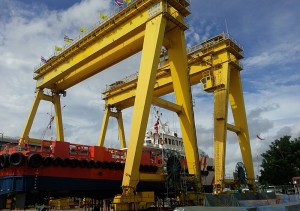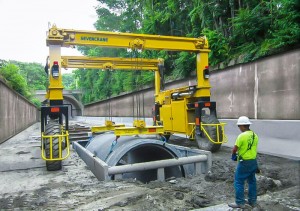
Shipping Container Gantry Crane for Outdoor
Components and Working Principle
A container gantry crane, also known as a ship-to-shore crane or a container handling crane, is a large crane used for loading, unloading, and stacking shipping containers at ports and container terminals. It consists of several components that work together to perform its tasks. Here are the main components and the working principle of a container gantry crane:
Gantry Structure: The gantry structure is the main framework of the crane, consisting of vertical legs and a horizontal gantry beam. The legs are firmly anchored to the ground or mounted on rails, allowing the crane to move along the dock. The gantry beam spans between the legs and supports the trolley system.
Trolley System: The trolley system runs along the gantry beam and consists of a trolley frame, spreader, and hoisting mechanism. The spreader is the device that attaches to the containers and lifts them. It can be a telescopic or fixed-length spreader, depending on the type of containers being handled.
Hoisting Mechanism: The hoisting mechanism is responsible for lifting and lowering the spreader and containers. It typically consists of wire ropes or chains, a drum, and a hoist motor. The motor rotates the drum to wind or unwind the ropes, thereby raising or lowering the spreader.
Working Principle:
Positioning: The container gantry crane is positioned near the ship or container stack. It can move along the dock on rails or wheels to align with the containers.
Spreader Attachment: The spreader is lowered onto the container and securely attached using locking mechanisms or twist locks.
Lifting: The hoisting mechanism lifts the spreader and the container off the ship or ground. The spreader may have telescopic arms that can adjust to the width of the container.
Horizontal Movement: The boom extends or retracts horizontally, allowing the spreader to move the container between the ship and the stack. The trolley system runs along the gantry beam, enabling the spreader to position the container accurately.
Stacking: Once the container is in the desired location, the hoisting mechanism lowers it onto the ground or onto another container in the stack. Containers can be stacked several layers high.
Unloading and Loading: The container gantry crane repeats the lifting, horizontal movement, and stacking process to unload containers from the ship or load containers onto the ship.
Application
Port Operations: Container gantry cranes are essential for port operations, where they handle the transfer of containers to and from various transportation modes, such as ships, trucks, and trains. They ensure rapid and accurate placement of containers for onward transportation.
Intermodal Facilities: Container gantry cranes are employed in intermodal facilities, where containers need to be transferred between different modes of transportation. They enable seamless transfers between ships, trains, and trucks, ensuring efficient logistics and supply chain operations.
Container Yards and Depots: Container gantry cranes are used in container yards and depots for stacking and retrieving containers. They facilitate the organization and storage of containers in stacks several layers high, maximizing the use of available space.
Container Freight Stations: Container gantry cranes are utilized in container freight stations for the loading and unloading of containers from trucks. They facilitate the smooth flow of containers in and out of the freight station, streamlining the cargo handling process.







Product Process
The manufacturing process of a container gantry crane involves several stages, including design, fabrication, assembly, testing, and installation. Here is an overview of the product process of a container gantry crane:
Design: The process begins with the design phase, where engineers and designers develop the specifications and layout of the container gantry crane. This includes determining the lifting capacity, outreach, height, span, and other required features based on the specific requirements of the port or container terminal.
Fabrication of Components: Once the design is finalized, the fabrication of various components begins. This involves cutting, shaping, and welding steel or metal plates to create the main structural components, such as the gantry structure, boom, legs, and spreader beams. Components like hoisting mechanisms, trolleys, electrical panels, and control systems are also fabricated during this stage.
Surface Treatment: After fabrication, the components undergo surface treatment processes to enhance their durability and protection against corrosion. This may include processes like shot blasting, priming, and painting.
Assembly: In the assembly stage, the fabricated components are brought together and assembled to form the container gantry crane. The gantry structure is erected, and the boom, legs, and spreader beams are connected. The hoisting mechanisms, trolleys, electrical systems, control panels, and safety devices are installed and interconnected. The assembly process may involve welding, bolting, and alignment of the components to ensure proper fit and functionality.















